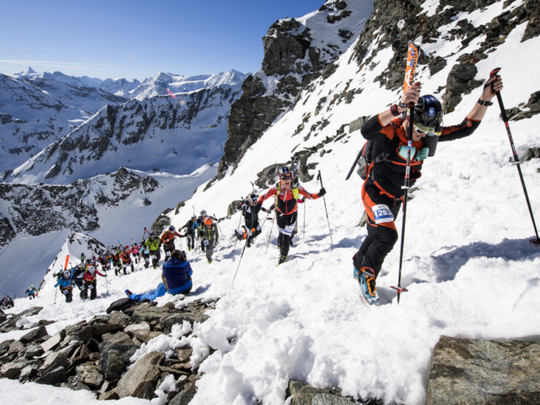
With global warming, we can make predictions and then take measurements to test those predictions. One prediction (a pretty obvious one) is that a warmer world will have less snow and ice. In particular, areas that have year-round ice and snow will start to melt.
Alpine glaciers are large bodies of ice that can be formed high in mountains, typically in bowls called cirques. The ice slowly flows downwards, pulled by gravity, and is renewed in their upper regions. A sort of balance can occur where the loss of ice by melting or flowing at the bottom is equal to the gain of snow and ice by precipitation.
As the Earth warms, the melt line moves upwards so that the glacier melts faster and faster at the bottom, shortening the glacier and reducing its mass. Ultimately, the melted water flows into streams and rivers and ends up in the oceans, contributing to accelerating sea level rise.
While glaciers are interesting from an intellectual standpoint, they are also important to ecosystems and society. For example, the rate of glacier melt affects downstream water levels, river flowrates, and the water available for human use. So, it would be really important for us to be able to predict what will happen with glaciers in the future and plan for how water availability will change.
Of the groups that track glaciers, my favourite is the World Glacier Monitoring Service, which publishes a survey of the mass changes from selected glaciers around the world. Their graph shows changes to the mass of the glaciers that are monitored, measured in millimetres of equivalent water.
But this doesn’t tell the whole story because there is very little information about glacier health in the high latitudes (Northern Alaska, Canada, Northern Europe, Northern Russia, etc.). Very few temperature records exist in high elevations in these regions. Furthermore, the temperatures do not extend back very far in time. So, it is challenging for scientists to develop a long-term perspective on glacier health in these areas.
And this is why a new study attracted my attention. A paper was just published by the American Geophysical Union that shared research carried out by Dominic Winski and his colleagues.
This team of researchers extracted ice cores from the glaciers on Mt. Hunter, in Alaska. The ice cores held snow and ice from as far back as 400 years. The researchers showed that the amount of water melt currently is 60 times greater than it was prior to 1850. They also found that the summertime temperature changes on Mt. Hunter are almost 2C per century (about 3.5F). To put this in perspective, the temperatures are rising about twice as fast as global temperatures.
The fact that temperatures on these northern mountains is rising faster than the globe as a whole is something predicted by climate models. The reason it warms so fast in these locations is that as the warming starts, snow begins to melt, exposing dark soil, which absorbs more sunlight, leading to more warming. We call this a feedback loop. There are other feedbacks at play, including changes to vertical temperatures in the air, changes to clouds, and changes to atmosphere currents. These areas were predicted to warm particularly fast, and the measurements confirm the predictions.
The authors recognised that during the summer, the top layer of snow and ice can melt. The liquid water permeates the ice beneath it and refreezes, creating a more solid ice layer than before. Because the bands of solid ice are formed from melting snow, more bands of solid ice mean that summer temperatures were above freezing when the ice bands formed. Measuring the number and thickness of these bands through time gives information about how warm the summer temperatures are.
So basically, the authors used these annual ice-core bands to deduce temperatures as far back as 400 years ago. They found that the frequency of melting events increased by 57-fold from the 1650-1850 time period compared with 1980-2011. They also measured a 60-fold increase in total melt. These are staggering numbers. I asked the lead author, Dominic Winski to summarise his findings and he told me,
This research shows that peaks in the Alaska Range sustain additional summertime warming through links with rising ocean temperatures in the tropics. Not only have we learnt that summers are much warmer on Mt. Hunter than they were hundreds of years ago, but our research also demonstrates how connected the climate system is, with changes in certain parts of the world affecting places thousands of miles away.
It will be interesting to see if others can replicate these findings in other locations. But the collaboration of the conclusions with other evidence is quite compelling. Good work, researchers.
— Guardian News & Media Ltd
Dr John Abraham is a professor of thermal sciences. He researches in climate monitoring and renewable energy generation for the developing world. His energy development work has extended to Africa, South America and Asia








